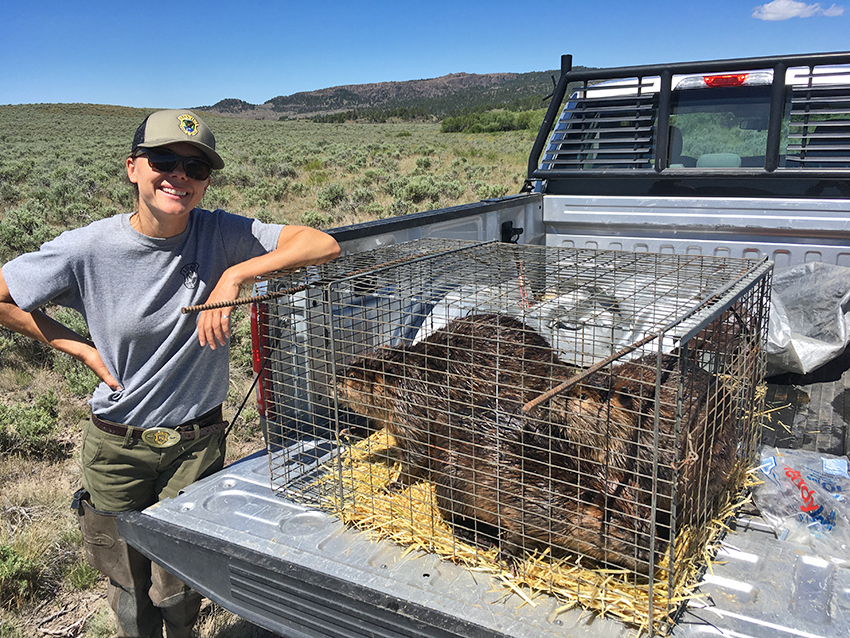Pittman-Robertson Is
For Beaver, Too
Leave it to the large rodent to make
habitat for deer and ducks

Wildlife biologist Jamie Utz, Idaho Department of Fish and Game, stands over beavers soon to be released in
Idaho’s rural Treasure Valley. The animals were trapped from an irrigation canal near Boise. Capture, quarantine and
transport protocols developed by a wildlife veterinarian guide Utz and her colleagues. (Photo: Cory Mosby, IDFG)
Editor’s Note: This feature arrives courtesy of Craig Springer (U.S. Fish & Wildlife Service), which showcases Pittman-Robertson funds at work.
All the wonders of nature are wrapped up in a 40-lb. densely furred, oily creature with orange ferrous-infused teeth, webbed feet and a scaled leathery tail. The American beaver possesses a fascinating way of life, always centered around water and a multi-aged family unit, always busy building dams and keeping up a lodge that houses them the year-round. Beaver do not hibernate.
If ever there’s an example of successful uses of Pittman-Robertson funds and wildlife restoration, it would be the beaver. They are not the high-profile white-tailed deer or pronghorn or ruffed grouse. But furbearers, beavers among them, are beneficiaries the excise taxes paid by the firearms, archery, and ammunition manufacturers. Here’s a brief, closer look.
Beaver Conservation — Past & Present
Centuries of unregulated harvest and the expansion of civilization and water development such as canals and locks and dams that follow in its wake caused beaver numbers to plummet.
A market for the animal’s fur used in fashion and its castor oil for fragrant perfumes kept steady and eventually unsustainable pressure on beaver populations throughout the country. Beaver pelts had long been a significant export to markets overseas, and the market for products coming from beaver exist today.
Beaver once ranged from Alaska to north Georgia, and Sonora to the Maritime Provinces. In short, where there was flowing water, beavers called it home. But by the turn of the twentieth century, much of the continental U.S. was depauperate of beaver colonies, particularly in eastern and midwestern states.
While beaver conservation got underway in the United States as early as the 1890s, Pittman-Robertson — which became law in 1937 — juiced restoration, as it did for many other depauperate species of wildlife, furred and feathered.
The steady and reliable funding source is still used today for beaver management, and it is essential says Cory Mosby, furbearer biologist with Idaho Department of Fish and Game.
“Pittman-Robertson pays the way for population surveys in the field, trapper harvest assessments, data collection for season and harvest limit setting, and live-trap and transport,” said Mosby. “We’re restoring beaver populations where they once occurred, with strategic intent on gaining other management objectives.”
Southern Idaho is arid. Natural flowing water in “big, wet veins,” as Mosby calls them, is premium. Returning beavers to water courses in that area is a value-added habitat treatment. Beaver dams spread water, improve streamside vegetation, and make habitat for mule deer fawns, brood rearing sites for sage grouse and forage for elk.
Let’s not forget the fish. Beaver dams catch sediment and improve spawning and nursery habitat for unique native Yellowstone cutthroat trout that persist along the Idaho’s southern border. Mosby’s colleagues working in state fish hatcheries (funded by Dingell-Johnson excise taxes on fishing tackle) rely on those trout as a brood stock source for their own fish restoration endeavors.
Approximately 2,000 people buy a trapping license in Idaho each year, and harvest 4,000 beaver, according to Mosby. And he knows what drives trappers: Pittman-Robertson-funded surveys revealed beaver trappers are motivated to be close to nature, by the challenge of trapping, and to participate in wildlife management.
“Trappers spend more days afield than do hunters and anglers,” said Mosby. “They are dedicated to conservation—and it’s a lifestyle choice. Making money from pelts is a minor consideration.”
Beaver Management In Other Locales
The Indiana Department of Natural Resources issues twice the number of trapping licenses as Idaho, and Indiana trappers harvest half as many on an annual basis, according to furbearer biologist Geriann Albers. Beaver management in the more populated Midwest has a slightly different complexion where concern for damage to private property and public health rise in importance.
“Regulated trapping and harvest maintain beaver populations at a consistent, acceptable level,” said Albers. “Pittman-Robertson dollars fund our data collection and analysis, which informs future seasons and harvest limits.”
Trapping in Indiana enjoys a high level of public acceptance, according to Albers, because it is regulated and beaver management is guided by data. Paddlers augment data collection. Some 2,600 volunteer canoeists and kayakers observe and report on beaver sightings, revealing trends over time.
In the Land of 10,000 Lakes, Minnesota’s 1,200 beaver trappers harvest 60,000 pelts a year. John Erb, Minnesota Department of Natural Resources furbearer biologist, says the beaver population is healthy, their numbers abundant. But that has not always been the case.
“Beaver numbers were down for a time,” said Erb. “Trapping season was closed from 1909 to 1919, at which time trapping was allowed to remove nuisance animals only, until 1938. Trapping has been permitted every year since, except for a couple of drought years.”
Science-based regulations have allowed a steady increase in sustainable harvest. Today, the season runs from October to May, and there is no limit on harvest.
Pittman-Robertson dollars were used in Minnesota starting in 1958, paying for surveys of beaver habitat. Biologists flew over stream courses, counting lodges and dams from the air, and did this repeatedly year after year until 2001. The accumulation of data over a long span revealed trends and informed management choices through the years that allowed for tailored management.
“In northern Minnesota, our beaver management focus is to minimize conflicts with road culverts,” said Erb. “Beaver dams can confound waterfowl management and create problems for wild rice in the floating leaf stage. People harvest the rice, particularly some Native American tribes, and ducks eat it, too.”
Keepin’ Busy — No Pun Intended
Busy beavers are always eager to form water courses to their innate liking. That might conflict with a landowner who enjoys the shade of an ancient cottonwood. On the other hand, beavers are a benison to biologists who endeavor to improve the lot of a litany of animals.
“Beaver are wicked cool,” said Mosby. “Nature endowed them with goggles so they can see underwater. They hold their breath up to 15 minutes and gnaw trees underwater with their front teeth—with their mouth closed. Their presence and the market for their fur essentially laid the foundation for westward American settlement. They have been busy for a long time — no pun intended.”
Check out this story map, where you can see a circa 1950 video of parachuting beavers.




